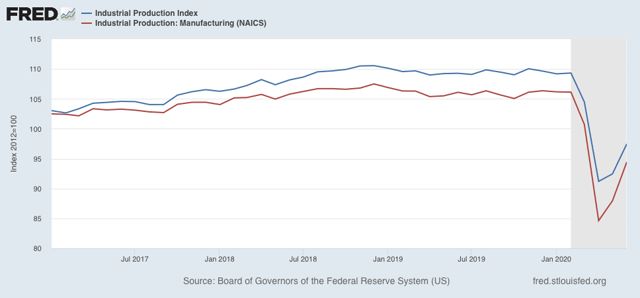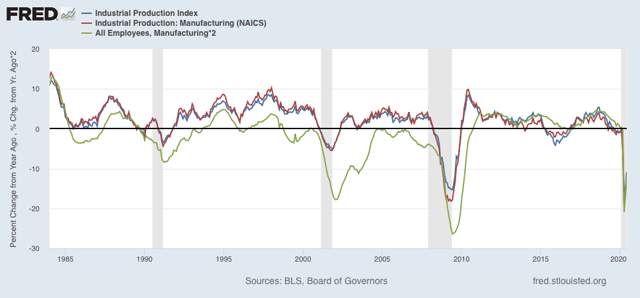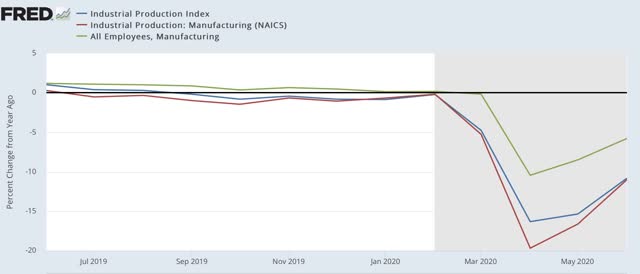Industrial production is the King of Coincident Indicators. The NBER almost always identifies month of the end, and frequently the beginning, of recessions based on the top and bottom of this statistic. This morning it was reported to have risen for the second month in a row in June. Let’s take a little deeper look.
First, here’s the graph of both overall (blue) and manufacturing (red) production since Trump was inaugurated in January 2017:

Both rose by a total of 5% or more until December 2018. In that month both peaked, and both have been in declines since then, first shallow, and then collapsing when the coronavirus hit in March. As of this morning’s report, overall production has regained about 1/3 of its loss since December 2018. Manufacturing has regained about 1/2 of its loss.



President Biden’s First Day
NY Times – David Brooks – July 16
Donald Trump … Republicans will pretend they never heard his name. Republican politicians are not going to hang around a guy they privately hate and who publicly destroyed their majority.
But there will be a larger quiet, too. For two decades American politics has centered on a bitter culture war between the white working-class heartland and university-bred coastal elites.
Bill Clinton, Barack Obama and Hillary Clinton were all emblems of this university class, and it was easy for the Republican media wing to gin up resentment against them. In 2016, Trump beat Clinton among the white working class by a crushing 28 points.
But Biden is not an emblem of this coastal elite. His sensibility was nurtured by his working-class family during the postwar industrial boom of the 1950s and 1960s. He graduated from the University of Delaware in 1965 and missed the late 1960s culture war that divided a generation.
It’s very hard for conservatives to demonize Biden because he comes from the sort of background that Trumpian conservatives celebrate. He elides all the culture war divides. He doesn’t act superior to the “deplorables,” because his family taught him to despise status games of all sorts.
It will become immediately clear that in a Biden era politics will shrink back down to normal size. It will be about government programs, not epic wars about why my sort of people are morally superior to your sort of people. In the Trump era a lot of people who don’t care about government got manic about politics.
It will also become immediately clear that in a highly ideological age, America will be led by a man who is not ideological.
This week a few of us columnist types spoke with Biden about his economic plans. His most telling sentence was, “I’ve kind of tried to shed the labels and focus on the nuts and bolts of this.”
I asked him to describe the big forces that have flattened working-class wages over the past decades. Other people would have spun grand theories about broken capitalism or the rise of the corporate oligarchy. But Biden pointed to two institutional failures — the way Republicans have decentralized power and broken Washington and the way Wall Street forces business leaders to focus obsessively on the short term.
Biden’s worldview seems to come mainly from lived experience, not a manifesto somewhere. He has lived experience of a time when there were good manufacturing jobs, when unions protected workers, when the less affluent had a ladder to climb.
His economic agenda, promoted under the slogan “Build Back Better,” is about that, not some vast effort to remake capitalism or build a Nordic-style welfare system. The agenda is more New Deal than New Left.
In the two speeches he has delivered so far there are constant references to our manufacturing base — infrastructure, steelworkers, engineers, ironworkers, welders, 500,000 charging stations for electric cars. “When I think of climate change, the word I think of is jobs,” he declared.
The agenda pushes enormous resources toward two groups: first, African-Americans, who have been pummeled by deindustrialization for decades; and second, white working-class Trump voters. This looks like an attempt to rebuild the New Deal coalition and win back the white working class who should be a core of the Democratic base. Biden’s populist “Buy American” messaging is just icing on that cake.
Can he pull off this manufacturing revival and this political realignment?
I’ll be curious to see if it’s possible to create millions of manufacturing jobs — or if technology means there’s only a need for relatively few workers. I’ll be curious to see if he can tamp down the Democratic media and activist wings, with their penchant for wildly unpopular moral gestures like “defund the police” and “decriminalize the border.”
I wonder if the economic crisis will obviate all this. With mass unemployment the need will be to get money out the door immediately on Day 1. Launching infrastructure projects and clean energy industries takes a lot of time.
But I do know that if he can win a chunk of the white working class (44 percent of the electorate, according to Ruy Teixeira), he will realign American politics. I also know that from that first day the Biden agenda will put the surviving Republicans in Congress in an awful bind. Do they cooperate and work with Biden’s infrastructure and manufacturing plans? If they oppose him they give him a clear shot to win their voters while also inviting him to end the filibuster.
Everybody says Biden is a moderate, and in intellectual and temperamental terms that is true. But he has found a way to craft an agenda that could reshape the American economy and the landscape of American politics in fundamental ways.
Joe Biden may turn out to be what radical centrism looks like.
Biden’s worldview seems to come mainly from lived experience, not a manifesto somewhere. He has lived experience of a time when there were good manufacturing jobs, when unions protected workers, when the less affluent had a ladder to climb.
His economic agenda, promoted under the slogan “Build Back Better,” is about that, not some vast effort to remake capitalism or build a Nordic-style welfare system. The agenda is more New Deal than New Left.
In the two speeches he has delivered so far there are constant references to our manufacturing base — infrastructure, steelworkers, engineers, ironworkers, welders, 500,000 charging stations for electric cars. “When I think of climate change, the word I think of is jobs,” he declared. …
Yeah, but manufacturing jobs stopped growing by 1948(1925 ex dod). Yet it’s wages sky rocketed compared to the booming service sector of the post war era. It creates resentment of workers. Capitalism just looks gassed. Pop culture is out of gas. The party is ending.
(Of course now the service sector growth since 2001….mmmmmmm).
That map is incorrect in its plotting. Try again. 1979 may have the cycle height, but in general growth, 1948 was the peak. Look at the range in the 1825-1925 era. Persistent growth.
That map is incorrect in its plotting. Try again. 1979 may have the cycle height, but in general growth, 1948 was the peak. Look at the range in the 1825-1925 era. Persistent growth.
Nigh, your not be including commodity workers. Run……you know how shitty the 60’s were for them. Mmmmmmmm, it’s over. Manufacturing is a low labor capital intensive business now. The consolidation started in the 20’s.
Citation. Drucker would tell you that labor content was at its highest in the sixties and the decline of it and the cost of it started about that time. PS: those are BLS numbers. It is not a map.